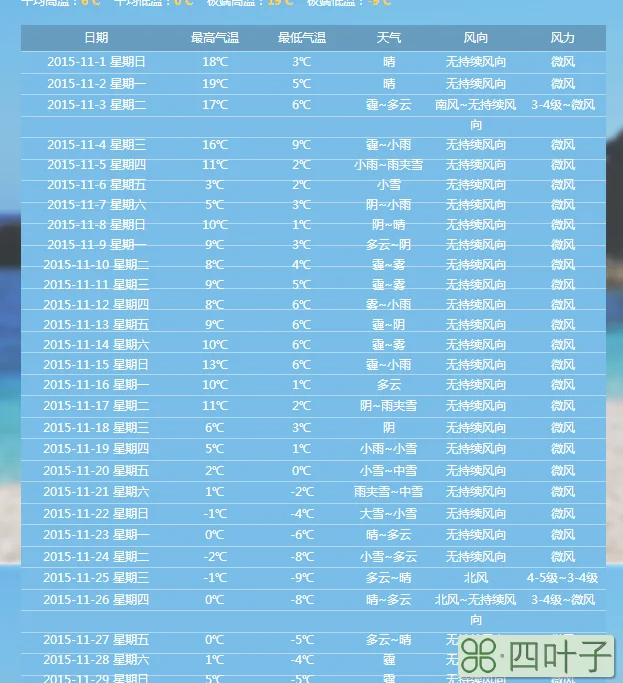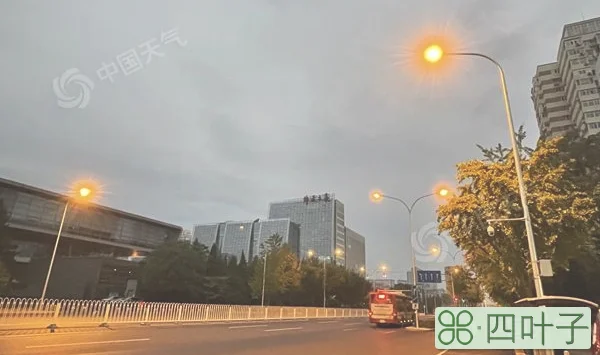查看北京天气查看北京天气预报一周
作者 杜雨
本文转自数据小魔方查看北京天气,转载需授权
还记得之前推送过的一篇讲大连天气数据可视化的文章吗,后来有小伙伴儿直呼不过瘾,墙裂要求来一个北京版。
小编查看北京天气我日夜赶工,终于出炉查看北京天气了北京版的空气质量数据可视化,而且相比之前大连版的有所升级查看北京天气:
时间区间增加到了连续三个年度(2014~2016)
图表形式不再局限于年度日历热图,而且增加了矩阵热图和圆环堆积热力图。
圆环图提供了基于 ggplot 函数的多种实现方法。
以下是整个数据可视化的处理过程
加载包:(我一向习惯在文首加载所有必要的软件包)
library(RCurl)
library(XML)
library(dplyr)
library(ggplot2)
library(stringr)
library(rvest)
library(lubridate)
library("DT")
library(openair)
library(ggplot2)
library(reshape2)
library(RColorBrewer)
library(scales)
library(showtext)
library(grid)
library(Cairo)
根据要爬取网址的数据链接结构手动构造网址链接使其遍历所有需要爬取的网页(当然这个过时查看北京天气你完全可以通过请求网页的形式筛选文本并提取目标 URL,但是这样需要迂回很多步骤,需要考虑编码,查找路径,我也不是那种特勤快的人,看到有捷径能偷懒就绝不花冤枉时间。)
year<-2014:2016
month<-sprintf("%02d",1:12)
url<- paste("https://www.aqistudy.cn/historydata/daydata.php?city=北京&month=",expand.grid(year,month)$Var1
,expand.grid(year,month)$Var2,sep="")
以上过程构造了北京市 2014~2016 年三整年的历史空气质量数据网址链接(月份链接):
接下来 进入数据爬取阶段:
先写完一个看下具体情况
tbls<-read_html(url[1],encoding="utf-8")%>%html_table(.,header=TRUE,trim=TRUE);tbls<-tbls[[1]]
检查无误之后,构造下载循环函数:
mytable<-data.frame()
for (i in url){
Sys.sleep(sample(1:5,1))
fun<-function(m){
table<-read_html(m,encoding="utf-8")%>%html_table(.,header=TRUE,trim=TRUE)
table<-table[[1]]
}
mytable<-rbind(mytable,fun(i))
}
这里预览一下以上数据结构:
dim(mytable)
[1] 1096 11
attributes(mytable)$names
[1] "日期" "AQI" "范围" "质量等级" "PM2.5" "PM10" "SO2"
[8] "CO" "NO2" "O3" "排名"
datatable(mytable)
使用DT表格预览数据集:
mytable<-read.csv("beijingtianqi.csv",stringsAsFactors=FALSE,check.names=FALSE)
查看数据结构和变量属性是否符合分析需要:
str(mytable)
'data.frame':1096 obs. of 11 variables:
$ 日期 : chr "2014-01-01" "2014-01-02" "2014-01-03" "2014-01-04" ...
$ AQI : int 87 119 81 151 121 181 144 29 44 86 ...
$ 范围 : chr "76~99" "80~218" "38~202" "87~229" ...
$ 质量等级: chr "良" "轻度污染" "良" "中度污染" ...
$ PM2.5 : num 45 111.4 46.5 114.4 90.5 ...
$ PM10 : num 111.3 168.5 97.7 147 117.5 ...
$ SO2 : num 27.7 69.3 29 40 35.9 46.3 34.4 13 19.3 53.2 ...
$ CO : num 1.5 3.43 1.31 2.82 2.31 ...
$ NO2 : num 61.9 93.1 52 75.4 67 68.2 59.8 21.1 34.5 70.5 ...
$ O3 : int 64 17 65 10 57 11 55 59 65 28 ...
$ 排名 : int 32 66 41 112 67 104 85 9 25 58 ...
定义日期变量格式:
mytable$日期<-as.Date(mytable$日期)
names(mytable)[c(1,3,4,11)]<-c("date","Range","Level","Order")
mytable$Year<-year(mytable$date)
breaks<-c(0,50,100,150,200,300,500)
label<-c("excellent","good","Mild pollution","moderate pollution","heavy pollution ","serious pollution")
制作北京市 2014~2016三年度历史空气质量数据年度日历热图
filter(mytable,Year==2014)%>%calendarPlot(.,pollutant="AQI",breaks=breaks,labels=label,year=2014)
filter(mytable,Year==2015)%>%calendarPlot(.,pollutant="AQI",breaks=breaks,labels=label,year=2015)
filter(mytable,Year==2016)%>%calendarPlot(.,pollutant="AQI",breaks=breaks,labels=label,year=2016)
接下来让我们疯狂一把,将北京三年的空气质量指标AQI用一幅图形尽数呈现。
首先要生成一个副本数据:
mydata1<-mytable
读出数据存档:
write.table (mytable,"beijingtianqi.csv",sep=",",row.names=FALSE)
提取需要使用的目标变量:
mydata11<-mydata1[c("date","AQI","Year")]
myasst<-mydata11[mydata11$date %in% as.Date(c("2014-01-01","2015-01-01","2016-01-01")),]
mydata11<-rbind(mydata11,myasst)
因为作图需要,2016年是闰年,2月有29天,14、15年均为28天,会导致最终数据不等长,影响之后的图表制作过程,这里暂且将其去除。
mydata11<-arrange(mydata11,Year,date)
mydata11<-mydata11[mydata11$date!="2016-02-29",]
提取月份数据并构月份标签:
mydata11$Month<-month(mydata11$date)
mydata11$Monthdata<--5
mydata11$Monthjo<-ifelse(mydata11$Month%%2==0,"A","B")
circlemonth<-seq(15,345,length=12)
circlebj<-rep(c(-circlemonth[1:3],rev(circlemonth[1:3])),2)
构造年度ID、年份、以及之后作图需要用到的辅助数据:
mydata11$ID<-rep(seq(from=0,to=365),3)
mydata11$Year<-factor(mydata11$Year,order=T)
mydata11$Asst<-5
mydata11$Asst[mydata11$Year==2015]<-10
mydata11$Asst[mydata11$Year==2016]<-15
mydata11A<-mydata11[mydata11$Year==2014&mydata11$Monthjo=="A",]
mydata11B<-mydata11[mydata11$Year==2014&mydata11$Monthjo=="B",]
构造季度、季度标签,及其辅助数据:
mydata11$Quarter<-quarter(mydata11$date)
mydata11$Quarterdata<-20
mydata11C<-mydata11%>%filter(mydata11$Year==2014)%>%filter(Quarter %in% c(1,3))
mydata11D<-mydata11%>%filter(mydata11$Year==2014)%>%filter(Quarter %in% c(2,4))
circlequarter<-seq(45,315,length=4)
circleqd<-rep(c(-circlequarter[1],circlequarter[1]),2)
将数值型的AQI指数根据行业标准进行分割:
mydata11$FADD<-cut(mydata11$AQI,breaks=c(0,50,100,150,200,300,500),labels=c("0~50","51~100","101~150","151~200","201~300","301~500"),order=T)
作图方法1:(简便方法,但效果不太好调整)
CairoPNG(file="ECOCirclejj.webp",width=1488,height=996)
showtext.begin()
ggplot(data=mydata11)+
geom_tile(aes(ID,Year,fill=FADD))+
coord_polar(theta="x")+
expand_limits(ylim=c(-4,4))+
scale_fill_brewer(palette="YlOrRd",type="seq",direction=1,guide=guide_legend(reverse=TRUE))+
labs(title="2014~2016年度北京市空气质量水平可视化",subtitle="数据根据AQI指标水平进行分段分割",caption="Source:https://www.aqistudy.cn/",x="",y="",fill="")+
theme(
axis.text=element_blank(),
axis.title=element_blank(),
axis.ticks=element_blank(),
panel.background=element_blank(),
panel.grid=element_blank(),
panel.border=element_blank(),
legend.key.size=unit(1.2,'cm'),
legend.key.height=unit(1,'cm'),
legend.text.align=1,
legend.position=c(1,0.95),legend.justification=c(1,1),
legend.text=element_text(size=20,hjust=3,vjust=3,face="bold"),
plot.background=element_blank(),
plot.title=element_text(size=50,lineheight=1.5),
plot.subtitle=element_text(size=35,lineheight=1.5),
plot.caption=element_text(size=25,hjust=0,lineheight=1.2),
plot.margin=unit(c(.5,.5,.5,.5),"lines")
)
showtext.end()
dev.off()
这里使用geom_raster()图层进行映射(不支持极坐标转换)
breaks<-aggregate(ID~Month,data=mydata11[mydata11$Year==2014,],FUN=median)
CairoPNG(file="ECOCirclejjj.webp",width=1200,height=600)
showtext.begin()
ggplot(data=mydata11)+
geom_raster(aes(ID,Year,fill=FADD))+
scale_fill_brewer(palette="YlOrRd",type="seq",direction=1,guide=guide_legend(reverse=TRUE))+
scale_x_continuous(breaks=breaks[,2],labels=paste0(1:12,"月"))+
labs(title="2014~2016年度北京市空气质量水平可视化",subtitle="数据根据AQI指标水平进行分段分割",caption="Source:https://www.aqistudy.cn/",fill="")+
theme(
text=element_text(family="myfont"),
axis.text=element_text(size=20),
axis.title=element_blank(),
axis.ticks=element_blank(),
panel.background=element_blank(),
panel.grid=element_blank(),
panel.border=element_blank(),
legend.key.size=unit(1.2,'cm'),
legend.key.height=unit(1,'cm'),
legend.text.align=1,
legend.text=element_text(size=20,hjust=3,vjust=3,face="bold"),
plot.background=element_blank(),
plot.title=element_text(size=50,lineheight=1.5),
plot.subtitle=element_text(size=35,lineheight=1.5),
plot.caption=element_text(size=25,hjust=0,lineheight=1.2),
plot.margin=unit(c(.5,.5,.5,.5),"lines")
)
showtext.end()
dev.off()
作图方法2:(虽然代码多但是调整相对自由)
setwd("F:/微信公众号/公众号——数据小魔方/2017年4月/20170404")
font.add("myfont","msyhl.ttc")
CairoPNG(file="ECOCircle.webp",width=1488,height=996)
showtext.begin()
ggplot()+
geom_bar(data=mydata11A,aes(x=ID,y=Monthdata),stat="identity",width=1,fill="#ECEDD1",col="#ECEDD1")+
geom_bar(data=mydata11B,aes(x=ID,y=Monthdata),stat="identity",width=1,fill="#DFE0B1",col="#DFE0B1")+
geom_bar(data=mydata11C,aes(x=ID,y=Quarterdata),stat="identity",width=1,fill="#BDBDBD",col="#BDBDBD")+
geom_bar(data=mydata11D,aes(x=ID,y=Quarterdata),stat="identity",width=1,fill="#D4D2D3",col="#D4D2D3")+
geom_bar(data=mydata11[mydata11$Year==2016,],aes(x=ID,y=Asst,fill=FADD),stat="identity",width=1)+
geom_bar(data=mydata11[mydata11$Year==2015,],aes(x=ID,y=Asst,fill=FADD),stat="identity",width=1)+
geom_bar(data=mydata11[mydata11$Year==2014,],aes(x=ID,y=Asst,fill=FADD),stat="identity",width=1)+
scale_fill_brewer(palette="YlOrRd",type="seq",direction=1,guide=guide_legend(reverse=TRUE))+
coord_polar(theta="x")+
ylim(-20,20)+
guides(colour=guide_legend(reverse=TRUE))+
geom_text(data=NULL,aes(x=circlemonth,y=-2.5,label=paste0(1:12,"月"),angle=circlebj),family="myfont",size=7,hjust=0.5,vjust=.5)+
geom_text(data=NULL,aes(x=circlequarter,y=17.5,label=paste0(c("一","二","三","四"),"季度"),angle=circleqd),family="myfont",size=7,hjust=0.5,vjust=.5)+
annotate("text",x=0,y=-15,label="北京",size=25,hjust=.5,vjust=1,family="myfont") +
labs(title="2014~2016年度北京市空气质量水平可视化",subtitle="数据根据AQI指标水平进行分段分割",caption="Source:https://www.aqistudy.cn/",x="",y="",fill="")+
theme(
text=element_text(family="myfont"),
axis.text=element_blank(),
axis.title=element_blank(),

axis.ticks=element_blank(),
panel.background=element_blank(),
panel.grid=element_blank(),
panel.border=element_blank(),
legend.key.size=unit(1.2,'cm'),
legend.key.height=unit(1,'cm'),
legend.text.align=1,
legend.position=c(1,0),legend.justification=c(1,0),
legend.text=element_text(size=20,hjust=3,vjust=3,face="bold"),
plot.background=element_blank(),
plot.title=element_text(size=50,lineheight=1.5),
plot.subtitle=element_text(size=35,lineheight=1.5),
plot.caption=element_text(size=25,hjust=0,lineheight=1.2),
plot.margin=unit(c(.5,.5,.5,.5),"lines"),

)
showtext.end()
dev.off()
以上整个过程涉及到的处理方法比综合,有爬虫、数据清洗和字符串处理、时间格式转换和 ggplot 高级制图方法,如果感兴趣可以作为练习。
推荐阅读

